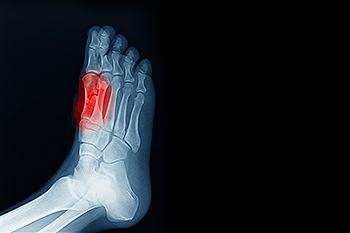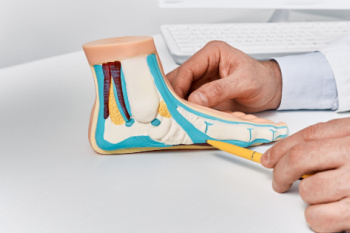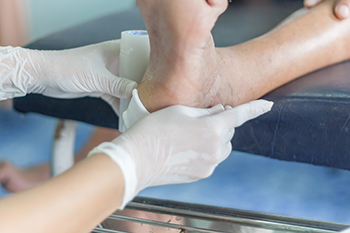Items filtered by date: June 2025
Wounds That Don't Heal Need to Be Checked
Sesamoiditis and Managing Pain Beneath the Big Toe

Sesamoiditis is the inflammation of the small sesamoid bones located beneath the big toe joint, causing pain and discomfort during movement. It is often caused by repetitive pressure from activities like running, dancing, or wearing high heels. Risk factors include having high arches, a sudden increase in activity, or improper footwear. Symptoms include aching pain under the big toe, swelling, and difficulty bending the toe. A podiatrist can evaluate your condition, recommend activity modifications, provide custom orthotics, and guide recovery through targeted care. If you are experiencing persistent forefoot pain, it is suggested that you visit a podiatrist to restore foot comfort and prevent further injury.
Sesamoiditis is an unpleasant foot condition characterized by pain in the balls of the feet. If you think you’re struggling with sesamoiditis, contact one our of podiatrists of The Foot and Ankle Specialists. Our doctors will treat your condition thoroughly and effectively.
Sesamoiditis
Sesamoiditis is a condition of the foot that affects the ball of the foot. It is more common in younger people than it is in older people. It can also occur with people who have begun a new exercise program, since their bodies are adjusting to the new physical regimen. Pain may also be caused by the inflammation of tendons surrounding the bones. It is important to seek treatment in its early stages because if you ignore the pain, this condition can lead to more serious problems such as severe irritation and bone fractures.
Causes of Sesamoiditis
- Sudden increase in activity
- Increase in physically strenuous movement without a proper warm up or build up
- Foot structure: those who have smaller, bonier feet or those with a high arch may be more susceptible
Treatment for sesamoiditis is non-invasive and simple. Doctors may recommend a strict rest period where the patient forgoes most physical activity. This will help give the patient time to heal their feet through limited activity. For serious cases, it is best to speak with your doctor to determine a treatment option that will help your specific needs.
If you have any questions, please feel free to contact our offices located in Houston and Deer Park, TX . We offer the newest diagnostic and treatment technologies for all your foot care needs.
Flat Feet in Women

Flat feet can have a significant impact on posture, movement, and stability, especially in females. The arch of the foot plays a key role in absorbing shock and distributing weight. When the arch collapses, it can affect balance, reduce agility, and place additional strain on core muscles, leading to fatigue and instability. Symptoms may include foot pain, swelling, and difficulty with physical activities. Risk factors include genetics, pregnancy, and obesity. A podiatrist can evaluate foot structure, recommend supportive footwear, and assign exercises that improve strength and alignment. If you have flat feet and notice persistent foot discomfort or instability, it is suggested that you consult a podiatrist for help in restoring function and improving overall movement.
Flatfoot is a condition many people suffer from. If you have flat feet, contact one our of podiatrists from The Foot and Ankle Specialists. Our doctors will treat your foot and ankle needs.
What Are Flat Feet?
Flatfoot is a condition in which the arch of the foot is depressed and the sole of the foot is almost completely in contact with the ground. About 20-30% of the population generally has flat feet because their arches never formed during growth.
Conditions & Problems:
Having flat feet makes it difficult to run or walk because of the stress placed on the ankles.
Alignment – The general alignment of your legs can be disrupted, because the ankles move inward which can cause major discomfort.
Knees – If you have complications with your knees, flat feet can be a contributor to arthritis in that area.
Symptoms
- Pain around the heel or arch area
- Trouble standing on the tip toe
- Swelling around the inside of the ankle
- Flat look to one or both feet
- Having your shoes feel uneven when worn
Treatment
If you are experiencing pain and stress on the foot you may weaken the posterior tibial tendon, which runs around the inside of the ankle.
If you have any questions, please feel free to contact our offices located in Houston and Deer Park, TX . We offer the newest diagnostic and treatment technologies for all your foot care needs.
Fractures in the Foot or Ankle During Childhood

Foot and ankle fractures are fairly common in children, especially those who are active in sports or play. These injuries happen when one or more bones break due to a fall, twist, or direct hit. Signs may include swelling, bruising, trouble walking, or the child refusing to put weight on the foot. Because children’s bones are still growing, some fractures affect growth plates, which are areas near the ends of bones that help shape future bone development. Treatment depends on the location and severity of the break. Some injuries may heal with rest, a cast, or a boot, while others may need more involved care to make sure the bones heal in the correct position. If your child has foot or ankle pain after an injury, it is suggested that you see a podiatrist to make sure proper healing can begin.
A broken foot requires immediate medical attention and treatment. If you need your feet checked, contact one our of podiatrists from The Foot and Ankle Specialists. Our doctors can provide the care you need to keep you pain-free and on your feet.
Broken Foot Causes, Symptoms, and Treatment
A broken foot is caused by one of the bones in the foot typically breaking when bended, crushed, or stretched beyond its natural capabilities. Usually the location of the fracture indicates how the break occurred, whether it was through an object, fall, or any other type of injury.
Common Symptoms of Broken Feet:
- Bruising
- Pain
- Redness
- Swelling
- Blue in color
- Numbness
- Cold
- Misshapen
- Cuts
- Deformities
Those that suspect they have a broken foot shoot seek urgent medical attention where a medical professional could diagnose the severity.
Treatment for broken bones varies depending on the cause, severity and location. Some will require the use of splints, casts or crutches while others could even involve surgery to repair the broken bones. Personal care includes the use of ice and keeping the foot stabilized and elevated.
If you have any questions, please feel free to contact our offices located in Houston and Deer Park, TX . We offer the newest diagnostic and treatment technologies for all your foot care needs.
Risks and Symptoms of Pressure Sores

Pressure sores, also called pressure ulcers or bed sores, can develop on the feet and ankles when these areas experience prolonged pressure or friction. They are more likely to affect people who have limited mobility, especially those confined to a bed or chair for long periods. Pressure sores often form over bony areas, like the heels or outer edges of the feet. The earliest sign may be a discolored patch of skin that does not lighten when pressed. As damage progresses, symptoms include pain, swelling, blistering, or drainage. In severe cases, these sores may develop into deep open wounds that are at risk of infection. People with diabetes, poor circulation, or limited sensation in their feet are at greater risk. A podiatrist can help by examining the skin, diagnosing the stage of the pressure sore, and recommending appropriate treatment. In advanced cases, surgery may be required to remove damaged tissue to help the area heal. If you have developed pressure sores on your feet, it is suggested that you schedule an appointment with a podiatrist for an exam and appropriate treatment options.
Wound care is an important part in dealing with diabetes. If you have diabetes and a foot wound or would like more information about wound care for diabetics, consult with one our of podiatrists from The Foot and Ankle Specialists. Our doctors will assess your condition and provide you with quality foot and ankle treatment.
What Is Wound Care?
Wound care is the practice of taking proper care of a wound. This can range from the smallest to the largest of wounds. While everyone can benefit from proper wound care, it is much more important for diabetics. Diabetics often suffer from poor blood circulation which causes wounds to heal much slower than they would in a non-diabetic.
What Is the Importance of Wound Care?
While it may not seem apparent with small ulcers on the foot, for diabetics, any size ulcer can become infected. Diabetics often also suffer from neuropathy, or nerve loss. This means they might not even feel when they have an ulcer on their foot. If the wound becomes severely infected, amputation may be necessary. Therefore, it is of the upmost importance to properly care for any and all foot wounds.
How to Care for Wounds
The best way to care for foot wounds is to prevent them. For diabetics, this means daily inspections of the feet for any signs of abnormalities or ulcers. It is also recommended to see a podiatrist several times a year for a foot inspection. If you do have an ulcer, run the wound under water to clear dirt from the wound; then apply antibiotic ointment to the wound and cover with a bandage. Bandages should be changed daily and keeping pressure off the wound is smart. It is advised to see a podiatrist, who can keep an eye on it.
If you have any questions please contact our offices located in Houston and Deer Park, TX . We offer the newest diagnostic and treatment technologies for all your foot and ankle needs.

